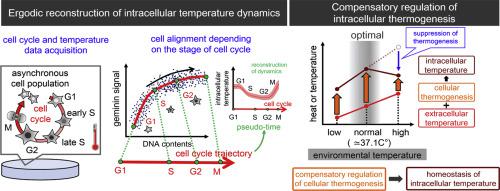Biochemical and Biophysical Research Communications ( IF 2.5 ) Pub Date : 2020-09-11 , DOI: 10.1016/j.bbrc.2020.08.110 Ryu Yamanaka , Yutaka Shindo , Kohji Hotta , Noriko Hiroi , Kotaro Oka

|
Temperature governs states and dynamics of all biological molecules, and several cellular processes are often heat sources and/or sinks. Technical achievement of intracellular thermometry enables us to measure intracellular temperature, and it can offer novel perspectives in biology and medicine. However, little is known that changes of intracellular temperature throughout the cell-cycle and the manner of which cells regulates their thermogenesis in response to fluctuation of the environmental temperature. Here, cell-cycle-dependent changes of intracellular temperature were reconstructed from the snapshots of cell population at single-cell resolution using ergodic analysis for asynchronously cultured HeLa cells expressing a genetically encoded thermometry. Intracellular temperature is highest at G1 phase, and it gradually decreases along cell-cycle progression and increases abruptly during mitosis. Cells easily heated up are harder to cool down and vice versa, especially at G1/S phases. Together, intracellular thermogenesis depends on cell-cycle phases and it maintains intracellular temperature through compensating environmental temperature fluctuations.
中文翻译:

细胞生热可补偿环境温度波动以维持细胞内温度。
温度控制着所有生物分子的状态和动力学,几种细胞过程通常是热源和/或吸收器。细胞内测温的技术成就使我们能够测量细胞内的温度,并且可以为生物学和医学提供新的观点。但是,几乎不知道整个细胞周期内细胞内温度的变化以及细胞响应环境温度的波动调节生热的方式。在这里,使用遍历分析从单细胞分辨率的细胞群体快照中重建依赖细胞周期的细胞内温度变化,以遍历分析的方式对表达基因编码测温法的异步培养的HeLa细胞进行分析。G1期的细胞内温度最高,并随着细胞周期进程逐渐减少,并在有丝分裂过程中突然增加。容易加热的细胞更难冷却,反之亦然,尤其是在G1 / S阶段。总之,细胞内生热取决于细胞周期阶段,并且它通过补偿环境温度波动来维持细胞内温度。











































 京公网安备 11010802027423号
京公网安备 11010802027423号